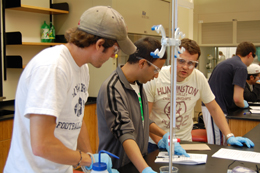Demonstrations › Acids, Bases, Buffers, Titrations

Acids, Bases, Buffers, Titrations
|
 (250x141).jpg) |
To a solution containing dilute sodium hydroxide and universal indicator, a piece of dry ice is added. The color change of the solution is observed as the solution is first neutralized then becomes acidic. |
|
| Simple buffer action is demonstrated by adding acid and base to equal volumes of water and buffer solutions at pH 4. |
|
|
 (250x141).jpg) |
The instructor breathes into a flask containing a colored solution. After several breaths, the color of the solution will change. |
|
| The buffering capacity of Alka-Seltzer is examined. |
|
|
 (250x141).jpg) |
Ammonia is added to a solution containing copper chloride, producing the deep blue adduct. When acid is added, the reaction is reversed. |
|
| The reaction of magnesium metal with different acids is used to measure their relative strengths. Hydrogen gas is formed during the reaction. Stronger acids will produce a more vigorous reaction with more bubbling. The increased bubbling with acids of different concentrations also demonstrates the affect of concentration on a reaction. |
 (250x141).jpg) |
|
 (250x141).jpg) |
The relative pH of some foods and household chemicals is illustrated by the use of Universal indicator. A Vernier pH meter can be used for more quantitative measurements. |
![]()
 (250x141).jpg)
 (250x188).jpg)
 (250x141).jpg)
 (250x141).jpg)
 (250x141).jpg)
 (250x141).jpg)
 (250x141).jpg)


